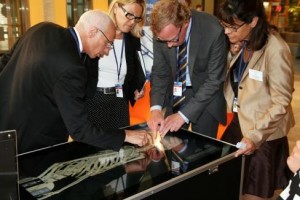Virtual Autopsy Touchscreen Table (videos)

Share

The Virtual Autopsy Table allows users to examine a 3D virtual cadaver using a touchscreen interface.
For those of you who miss playing Operation and want to take the game to the next level, may I present the Virtual Autopsy Table. Built more like a steamer trunk, the VAT allows you to use a multi-touch screen to explore a 3D virtual human body layer by layer. Developed in Sweden by the Noorkoping Visualization Center and the Center for Medical Image Sciences and Visualization, the body on display was painstakingly created using the latest in high resolution MRI scans. There's nowhere in the body you can't examine with a few flips of your hand across the screen. It's just like a real autopsy, only without all the goo. Check out the cool demonstration video after the break.
The virtual exploration of the body is a great educational tool for students and professionals. We've seen a similar 3D experience with Visible Body's online model. One day, the VAT could be an integral part of medical school, or even see use in museums across the world. The multi-touch screen is an intuitive way to access the information contained in the VAT, demonstrating how touchscreen technology is at the forefront of the new human-machine interface paradigm.
Perhaps more importantly though, the VAT is based on technology that is helping law enforcement agents solve crimes. As you'll see in this second video, the Noorkoping Visualization Center can use MRI and CT scans to examine the bodies of real victims, providing a means to perform an autopsy without a single cut. The results are crystal clear images that can help inform a jury as to the nature of a crime.
Be Part of the Future
Sign up to receive top stories about groundbreaking technologies and visionary thinkers from SingularityHub.


Both the VAT and the virtual autopsy technology behind it can explore the body being examined by peeling off layers. In this fashion you can look at the fractures in bones, or the damage to blood vessels without other body systems getting in the way of what you want to see. As with a traditional autopsy, cutting is an important tool, and virtual autopsies allow the use of a virtual knife to take cross sections of the body. As stated in the video, the ability to produce high resolution images of the exact location of damage on a corpse is an unparalleled tool in convincing jurists of the nature of a crime. In the justice system, seeing is believing, and providing information without the gruesome mood of an autopsy photo allows for a more welcome understanding in the courtroom.
While the VAT will likely prove a useful educational tool, and the virtual autopsy technology is already set to innovate the labs of medical examiners, the bigger story here is that the NVC made a touchscreen device at all. The Noorkoping Visualization Center's choice to produce a touchscreen version of their virtual autopsy is just one example in a trend of the wider use of the devices to engage audiences. While it doesn't have the flair of the touchscreen wall at the Hard Rock Cafe in Vegas, the VAT does fit a similar role: providing an intuitive way to share information quickly and effectively among several users at once. In the years ahead we may see more scientific and technical fields adapt technologies to be accessed in a touchscreen format. Maybe they'll make a virtual safari table for all you Hungry Hungry Hippos fans out there.
[photo and video credit: Norrkoping Visualization Center]
Related Articles

How Scientists Are Growing Computers From Human Brain Cells—and Why They Want to Keep Doing It

These Brain Implants Are Smaller Than Cells and Can Be Injected Into Veins

This Wireless Brain Implant Is Smaller Than a Grain of Salt
What we’re reading